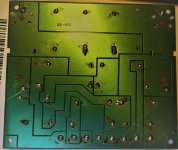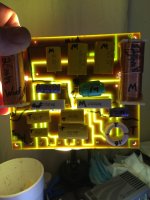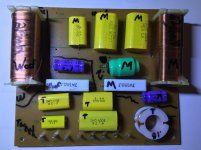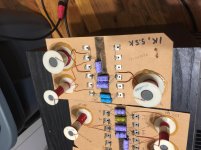Hello, I purchased some Epitome crossovers on Ebay and was trying to figure out exactly what they are. The specifications of them are 8 Ohms, -12db, 200-400w, 600-5k hz from the listing but I am not exactly sure if that is correct and I would like to know if its a Bessel, Linkwitz-Riley or Butterworth and if its all 2nd order and if crossover frequencies are 600 and 5k? Also if it is a second order butterworth do I need to reverse the polarity on mids or tweeters? I would greatly appreciate actual confirmation and not a guess answer if possible. Thanks again!😉
I also meant to mention that I marked out the componets in each circuit with T- tweeter , M- midrange and W- Woofer. Also as you can see in the pictures I measured the conductors and woofer is almost 2 mh and midrange is almost 3 mh and .2 mh and lastly the tweeter is .18 mh. Hope this helps.
I also meant to mention that I marked out the componets in each circuit with T- tweeter , M- midrange and W- Woofer. Also as you can see in the pictures I measured the conductors and woofer is almost 2 mh and midrange is almost 3 mh and .2 mh and lastly the tweeter is .18 mh. Hope this helps.
Attachments
Last edited:
It would be a lot easier to just test them than to figure it out from the layout.
Sorry, but not sure what you mean by test them?
Use a sound card and REW and input the signal to each section and plot the output. Its a basic skill for anyone working with crossovers. No cost since REW is free and I'm sure that you must have a computer with a sound card. Just need the connectors and that's not too tough.
Use a sound card and REW and input the signal to each section and plot the output. Its a basic skill for anyone working with crossovers. No cost since REW is free and I'm sure that you must have a computer with a sound card. Just need the connectors and that's not too tough.
Cool! 😛 I didn't know there was software out there that would do that. I will give it a try then. Thank you. learn something new every day. ha
You'll need a load resistor, by the way, so an 8 ohm resistor at the outputs will be needed.
You only need 1 resistor, as you'll measure 1 output at a time.
E
You only need 1 resistor, as you'll measure 1 output at a time.
E
Also, check out this page on basics of crossovers. You'll find it helpful in understanding what you are looking at:
https://speakermakersjourney.blogspot.com/2016/02/crossover-basics.html
https://speakermakersjourney.blogspot.com/2016/02/crossover-basics.html
You'll need a load resistor, by the way, so an 8 ohm resistor at the outputs will be needed.
You only need 1 resistor, as you'll measure 1 output at a time.
E
Thanks, Actually I was not thinking at all, but I have a Frequency generator and a Oscilloscope. Do I need to use load resister doing it this way as well? Also, I do have another question on the woofer circuit.
The woofer cuts out around 600 Hz but then starts coming back in around 800Hz at around 6db all the way up to 2k hertz which is confusing to me?
I looked at most 2nd order butterworth circuits and they show the conductor on the postive side of woofer in series and the capacitor across the negetive and positive woofer terminals. But this crossover has a 10 ohm resistor in series with a 10uf 100v capacitor across the woofer terminals. Is this the correct way to do it?
If I short out the resistor it drops almost half
That's a impedance flattening cell.
OR/AND is the capacitor that is "damped" so it makes a softer slope.
( for 2nd order )
Probably a mix of the two ( Woofer's Z flattening makes the inductor work better because there's no rising impedance ) but as a stock crossover it isn't tailored to the particular woofer that you're using.
OR/AND is the capacitor that is "damped" so it makes a softer slope.
( for 2nd order )
Probably a mix of the two ( Woofer's Z flattening makes the inductor work better because there's no rising impedance ) but as a stock crossover it isn't tailored to the particular woofer that you're using.
The tweeter path: it's C-L-C so it's a 3rd order.
The midrange usually goes inverted, but you need to check the distance between the source(s). Most important thing is to keep (acoustic) phase at the crossover freq. between adiacent drivers.
The midrange usually goes inverted, but you need to check the distance between the source(s). Most important thing is to keep (acoustic) phase at the crossover freq. between adiacent drivers.
The transfer function of a crossover depends on che crossover elements and the impedance (which is not constant but varies with frequency).
The transfer function will then interact with the in box/on baffle frequency response of the drivers. This will give the rolloffs, but the order and type depend on all the above.
So asking what crossover frequencies provides this particolar board or if a driver ahould be reversed doesn't make much dense.
Just as an example, it is pretty easy to build acoustic LR4 slopes on a mid-tweeter crossover using a 2nd order electrical crossover on the mid and a 3rd order electrical on the tweeter. And as a result the drivers will be connected with the same polarity.
Ralf
If it is a generic crossover, throw it away. If it is a tailored crossover, then you need to use it with the drivers and box for which the crossover has been designed.
The transfer function will then interact with the in box/on baffle frequency response of the drivers. This will give the rolloffs, but the order and type depend on all the above.
So asking what crossover frequencies provides this particolar board or if a driver ahould be reversed doesn't make much dense.
Just as an example, it is pretty easy to build acoustic LR4 slopes on a mid-tweeter crossover using a 2nd order electrical crossover on the mid and a 3rd order electrical on the tweeter. And as a result the drivers will be connected with the same polarity.
Ralf
If it is a generic crossover, throw it away. If it is a tailored crossover, then you need to use it with the drivers and box for which the crossover has been designed.
The transfer function of a crossover depends on che crossover elements and the impedance (which is not constant but varies with frequency).
The transfer function will then interact with the in box/on baffle frequency response of the drivers. This will give the rolloffs, but the order and type depend on all the above.
So asking what crossover frequencies provides this particolar board or if a driver ahould be reversed doesn't make much dense.
Just as an example, it is pretty easy to build acoustic LR4 slopes on a mid-tweeter crossover using a 2nd order electrical crossover on the mid and a 3rd order electrical on the tweeter. And as a result the drivers will be connected with the same polarity.
Ralf
If it is a generic crossover, throw it away. If it is a tailored crossover, then you need to use it with the drivers and box for which the crossover has been designed.
Thanks Pico and Ralf,
Maybe I should just explain what I am trying to do. and maybe you can tell me if this crossover will work or if I need to modify it or just build one. Promise you won't laugh though.... I bought a set of Fisher ST-925 for almost nothing, but as you know they suck! Mainly because of the crossover being a two-way from the factory and sending straight signal to the 15 inch woofer. I purchased the Epitome crossover on Ebay for $10 each and they do make the speaker sound so much better but I just wanted to make sure they were close enough to work with the drivers and if I needed to invert phase on the mid or tweeter. So please tell me what you think would be the best thing to do to make these Fishers sound their best? with out laughing!😀
Believe it or not I do own a decent set of speakers "Paradigm studio 100's"ran by Yamaha CX-1000 and MX-1000 separates. But the fishers are going in my shop along with an older Marantz SR18.
Attachments
It can be designed this way if the woofer has a high inductance, in other words if it already has a sort of low pass filter built in.I bought a set of Fisher ST-925 for almost nothing, but as you know they suck! Mainly because of the crossover being a two-way from the factory and sending straight signal to the 15 inch woofer.
It is impossible to say without FR and impedance measurement of the Fisher drivers into the the Fisher box. A redesign of a crossover of an existing commercial speaker can be done, but it is a task for an experienced designer. If you want to fiddle with your strange couple start with inverting both mid and tweeter, but expect to have at least mutual SPL of the drivers off.I purchased the Epitome crossover on Ebay for $10 each and they do make the speaker sound so much better but I just wanted to make sure they were close enough to work with the drivers and if I needed to invert phase on the mid or tweeter. So please tell me what you think would be the best thing to do to make these Fishers sound their best?
Ralf
I am exactly doing the same thing. i.e. replacing the crossover of a DIY 3way speaker Link is here. 3 way . Being a newbie and having no frequency generator (I followed direction of ESP website of speaker measurement link ) I created various frequency tones online in wav format link. copied to laptop. Headphone out was given to aux of my amplifier. On each tone I adjusted the output to be constant and measured the voltage across resistor as mentioned in the website. That way I got rough values of frequency resonance of drivers.
Regards.
Regards.
So we are now getting the particulars: Fisher ST-925 speakers
With 4 Ω drivers, the only usable components in the new X-O are in the woofer path.
Now you have your woofer band-limited, which is correct.
Since it's lowpassed, the tiny old midrange won't cut for the new project ( it's also 4Ω, so it doesn't work with the 3 way X-O ) as it has to emit much lower.
Try to search for a 6-8" mid-woofer with 8Ω impedance.
Also 8 Ω imp. tweeter is required for the new X-O.
But first of all, you have to define the level of the woofer "under" the low pass.
So, connect the woofer only. You want also the box+woofer to be defined; you can put it upside down, cover the two holes and start from here.
The midrange will then be housed outside, on top of the woofer ( no box is needed ), and the tweeter either. Also a WTM can be made, instead of WMT
With 4 Ω drivers, the only usable components in the new X-O are in the woofer path.
Now you have your woofer band-limited, which is correct.
Since it's lowpassed, the tiny old midrange won't cut for the new project ( it's also 4Ω, so it doesn't work with the 3 way X-O ) as it has to emit much lower.
Try to search for a 6-8" mid-woofer with 8Ω impedance.
Also 8 Ω imp. tweeter is required for the new X-O.
But first of all, you have to define the level of the woofer "under" the low pass.
So, connect the woofer only. You want also the box+woofer to be defined; you can put it upside down, cover the two holes and start from here.
The midrange will then be housed outside, on top of the woofer ( no box is needed ), and the tweeter either. Also a WTM can be made, instead of WMT
T/S parameters are pretty useless when it comes to crossover design. Apart the graph of the impedance (pretty easy to measure), what you need here is the FR of the driver on the baffle you're using, and this means you need a calibrated mic. Such a device doesn't cost an arm and a leg, but it can be questioned if it is a sensible cost for a one-shot project.
Ralf
Impedance can be easily measured this way: AudioBlog: A simple loudspeaker measurement jig for ARTA
Ralf
Impedance can be easily measured this way: AudioBlog: A simple loudspeaker measurement jig for ARTA
Seriously, I would scrap the oscilloscope and go to a computer based system. This is the modern world, get with it! There is a learning curve but that's all. The cost, which used to be prohibitive, is now almost nothing.
Off the shelf 3 way crossovers have a lot of variations on a theme.
Crossovers
Impedance of drivers. 4 or 8 ohm.
Crossover frequency to the mid. 300Hz or 800Hz.
Complexity. 4 element mid or two element mid.
If I was looking at your speaker, I would say it's not wildly different form this Troels Gravesen SEAS 503 renovation.
SEAS Kit 503
Phase depends on the filter to some extent. You'd really need to trace the exact schematic and the values. If it's a two element mid, polarity is possibly +-+. If it's a 4 element mid, polarity might be +--.
Like Earl (gedlee) says. A simulator might help a lot.
Downloads
You might find a similar projekte to import into Boxsim here:
https://boxsim-db.de/kategorie/systeme/drei-wege/
Or you find something similar box-wise, and use say, a 12" W300S, a 4" W100S and a 1" SC10N tweeter to get some idea of what is going on. That bullet tweeter must be loud.
Crossovers
Impedance of drivers. 4 or 8 ohm.
Crossover frequency to the mid. 300Hz or 800Hz.
Complexity. 4 element mid or two element mid.
If I was looking at your speaker, I would say it's not wildly different form this Troels Gravesen SEAS 503 renovation.
SEAS Kit 503
Phase depends on the filter to some extent. You'd really need to trace the exact schematic and the values. If it's a two element mid, polarity is possibly +-+. If it's a 4 element mid, polarity might be +--.
Like Earl (gedlee) says. A simulator might help a lot.
Downloads
You might find a similar projekte to import into Boxsim here:
https://boxsim-db.de/kategorie/systeme/drei-wege/
Or you find something similar box-wise, and use say, a 12" W300S, a 4" W100S and a 1" SC10N tweeter to get some idea of what is going on. That bullet tweeter must be loud.
- Status
- Not open for further replies.
- Home
- Loudspeakers
- Multi-Way
- Need help with crossover type!




